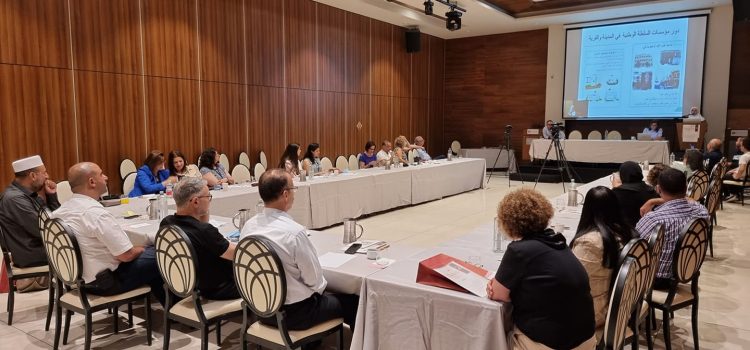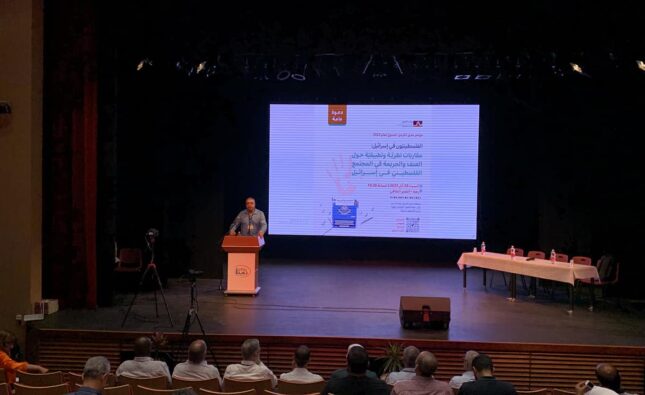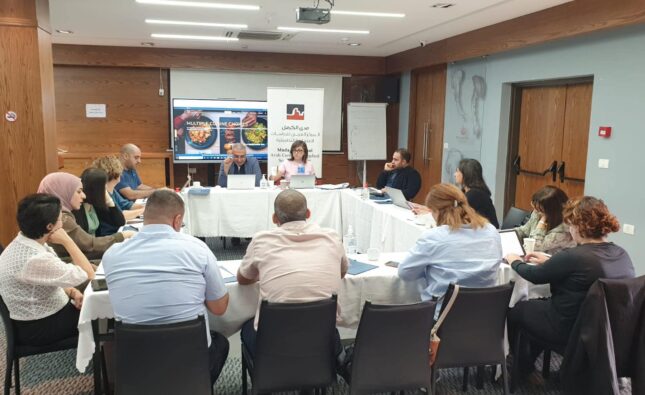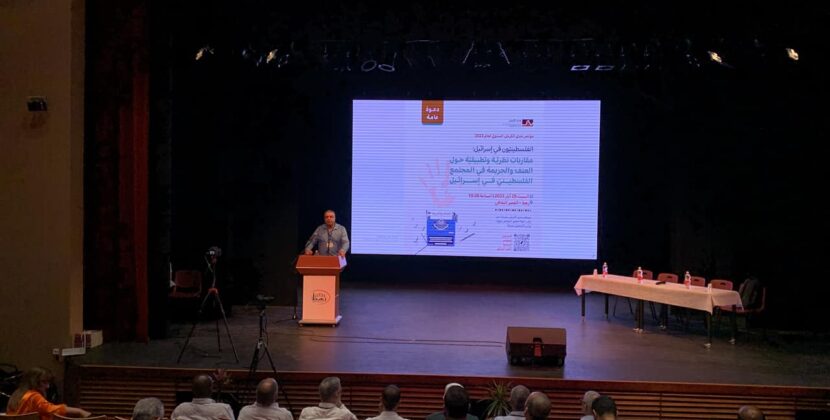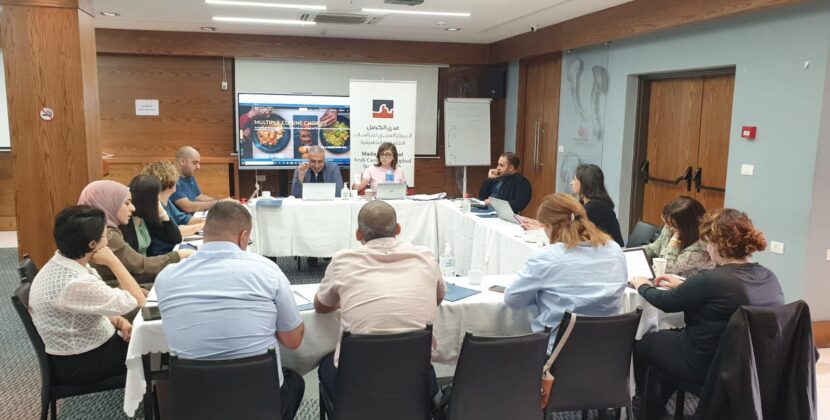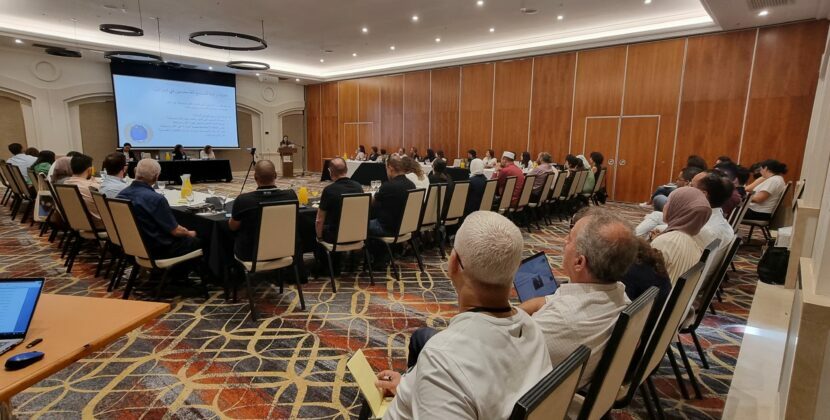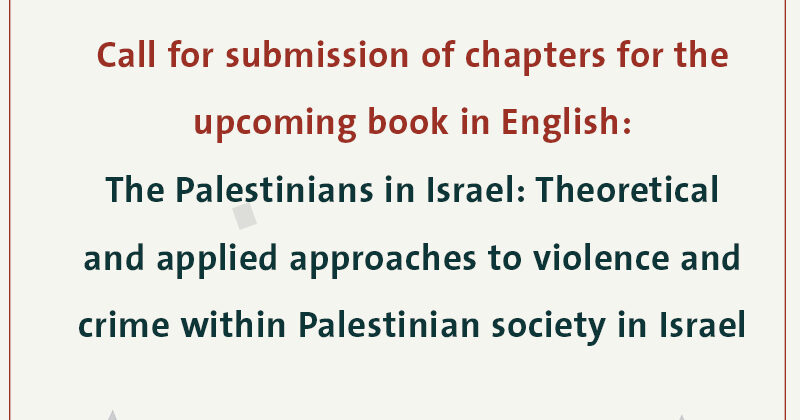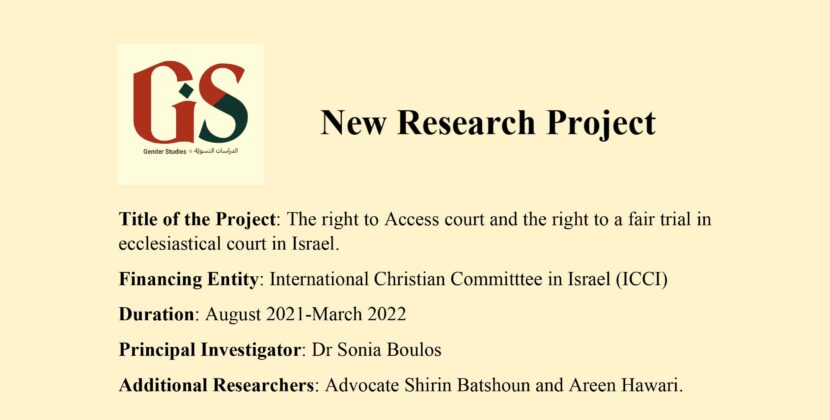For the seventh year in a row, with perseverance and determination, Mada Al-Carmel Center organized its seventh conference for Palestinian doctoral students, at Ramada Olivie Hotel in Nazareth, which was broadcasted for Mada Al-Carmel’s audience on its Facebook page. Over time, this conference has become “a spot for, cultural, interactive and deliberative knowledge, where Palestinian postgraduate students meet in Nazareth, with no boundaries, or barriers”, as Dr. Mohanad Mustafa (General Director of Mada Al-Carmel) explained in his opening speech of the conference. Mustafa added that “knowledge, its participation and its circulation are an affirmation of the premise that the cultural field has become – and would be – the field that unites Palestine and its people, under their will, more than the political field, which Israel attempts to enforce it on them against their will”. Dr. Mustafa also stressed that “such knowledge is not only circulated for the sake of gaining knowledge to understand political, social and economic phenomena, rather, it is a right gained for the sake of righteousness, that is, justice and the need to combat tyranny in all its social, political and economic forms”.
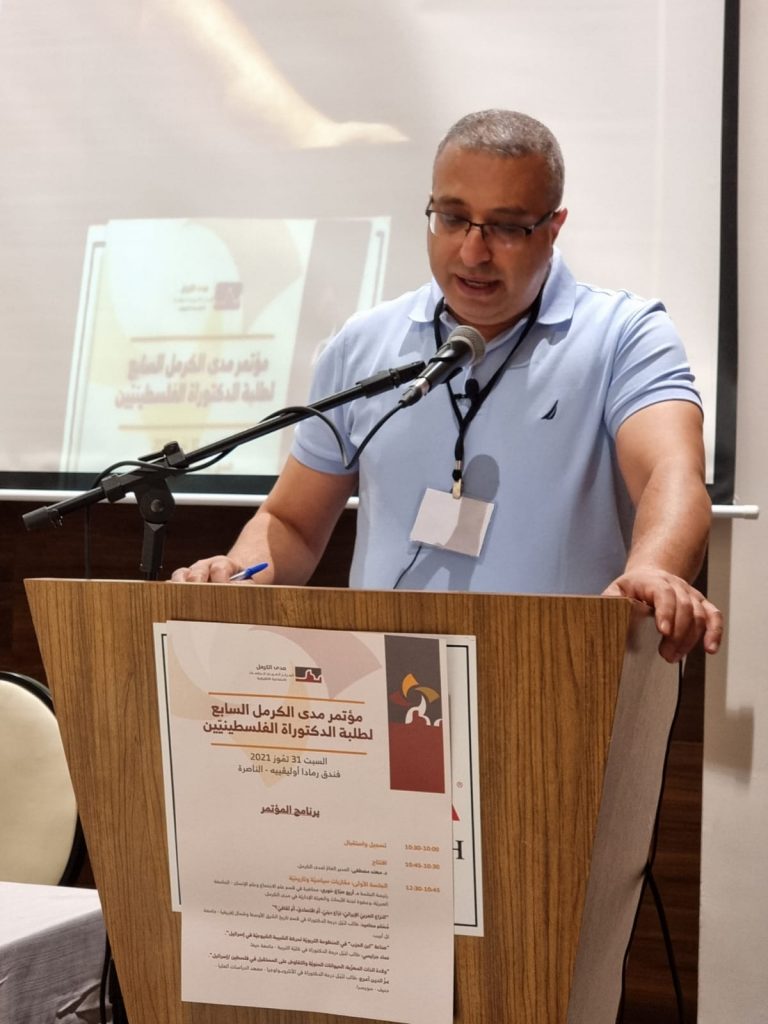
The conference hosted two sessions, the first one, entitled “Political and Historical Approaches”, was conducted by Dr. Areej Sabagh-Khoury (Lecturer in the Department of Sociology and Anthropology – Hebrew University, and member of the Research Committee and the Board of Directors of Mada Al-Carmel). This session included three interventions. In the first intervention, Asma Al-Sharbati, a Ph.D. student at the Doctoral Program for Social Sciences – Birzeit University, presented a paper entitled “How are Palestinians represented in their national school textbooks?” Al-Sharbati placed emphasis on school textbooks being political books, which have a major role in communicating implicit messages with political agendas that reflect the agendas of the national leaders, who have managed to shape its concepts. Such agenda is managed through studying the forms of the textbooks’ representation of different Palestinian groups and its varying effectiveness depending on their different places of residence: whether in the city, the village, the camp, al-badia, or the Diaspora. In these textbooks, Shrabati touched on the internal orientalist discourse appearing in the textbooks by illustrating how certain Palestinian groups (Bedouins; refugees; camp residents; the Diaspora) are represented as outsiders separated from the Palestinian people and alienated by referring to them in the third-person pronoun, as well as limiting the Palestinian institutional representation to Palestinians in the West Bank and Gaza only. In this regard, Shrabati invoked Oslo Accords and the geographical zoning into “A” – “B” – “C” zones, pointing out that the challenges of the Palestinian city and village are treated in a similar manner to those of cities and villages anywhere else in the world, without linking them to the effects of occupation on them, but with a slight limited allowance of acceptance of the reality of resistance. Sharbati concluded by claiming that the authority reproduces itself and its dominance by including its ideologies, and its enforced submission discourses in school textbooks.
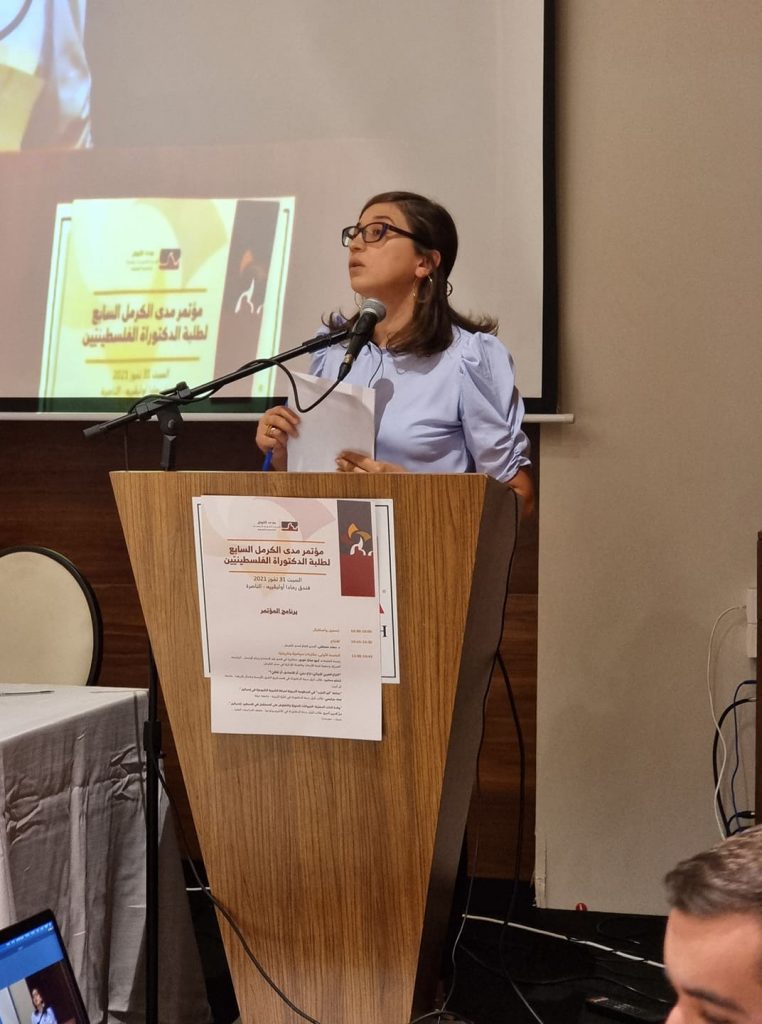

The second intervention, entitled “The Making of ‘the Sons of the Party’ in the Educational System of the Youth Communist Party in Israel”, presented by Imad Jaraisy, a Ph.D. student at the Faculty of Education – University of Haifa. Jaraisy discussed the nature of “making” and refining identity through ideological youth movements that are active among young Palestinians in Israel. In his intervention, he addressed the internal relationship between the fields of education and politics, and their role in discrediting the identity of young people, specifically in societies where there is a synergy between minority groups and the majority group. Jaraisy claimed that these ideological youth movements contribute in the making of the “Sons of the Party”, or in other words, the making of Party elites, who do not infringe on the Party’s boundaries, through actively participating in political work for the party. Jaraisy revealed one of the insights of his research; the creation of a new identity that amounts to an “embryonic” identity under the phase of development and creation, is called the “Palestinian-Israeli” identity. This embryonic identity syndicates national identity with citizen identity. On one hand, it prevents any kind of Palestinian incarceration within a collective national and cultural identity aiming at consolidating Palestinians within the Israeli society (not in an Israelization sense). On the other hand, it maintains a collective identity for all factions of the Palestinian society despite all the challenges that Palestinians are experiencing in Israel.
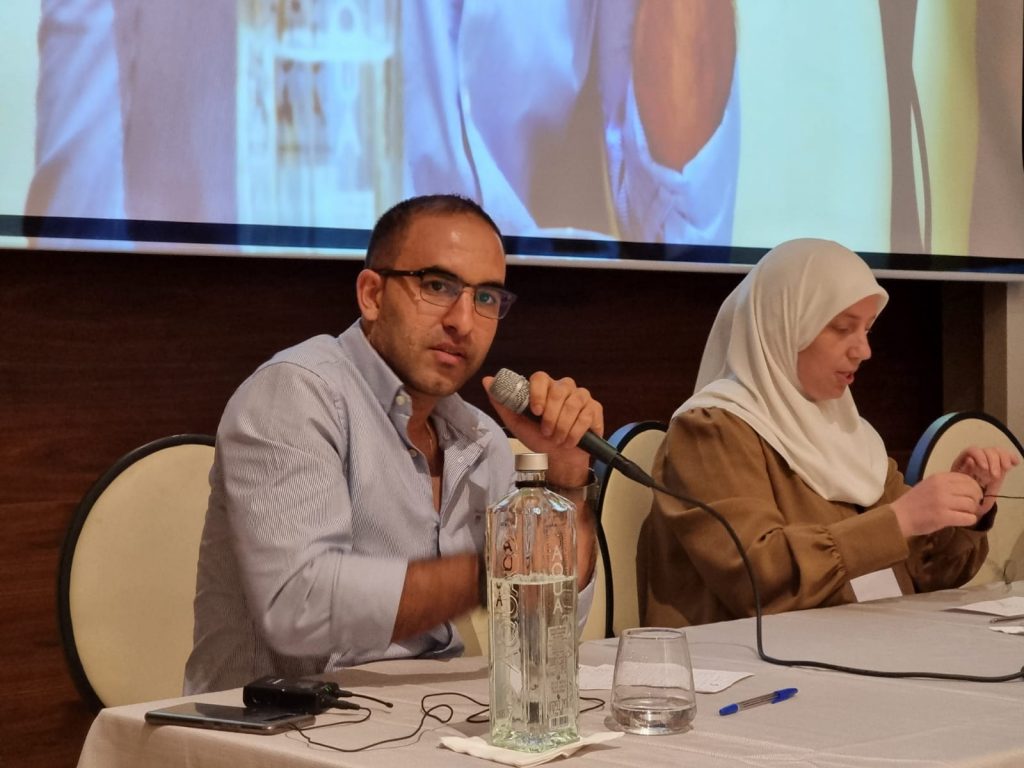
The third and final intervention of this session was entitled “The Birth of the Escaped Self: Sperms and the Negotiation on the Future in Palestine/Israel”, presented by researcher Izzedine Araj, a Ph.D. Student in Anthropology – Institute of Higher Studies, Geneva, Switzerland. In his discussion, Araj referred to the experience of smuggling sperms from Israeli prisons in the last nine years from the point of view of prisoners’ wives. He highlighted the complex and intricate connotations, between social, political, colonial, nationalist and religious perspectives, which are gained through this experience in a complex reality of uncertainty, isolation and family deprivation. Araj explains that, on one hand, women try to emphasize the importance of their roles by showing that they are loyal to the Palestinian struggle. On the other hand, they assert their right to claim a better social life, to improve their social and living conditions, and to negotiate and resist societal norms. He further explained how reproduction in this case would become a negotiating space for the future, the potential and the legitimacy of the act, and a quest for recognition, recovery and family preservation. In this kind of counter-domination, women speak about the future in the present form, as a way to emphasize the ability to redefine the future, the potential and what is possible. Araj argues that in the day-to-day reality of Palestinians, reproduction policies are not only about managing life itself, but also about managing what can be life, a conflict or a negotiation on the future.

The second session, entitled “Language and Educational Approaches”, was moderated by Dr. Hanin Qurwani Khouri, lecturer and researcher at the Department of Communication Disorders, Faculty of Social Welfare and Health Sciences, University of Haifa. During this session, three interventions were made, the first presented by Mona Abdel Razek, a Ph.D. student in linguistics in the Department of Literature and Linguistics – Bar-Ilan University. In her intervention, entitled “Documenting Language Skills for Palestinian Children Diagnosed with Autism Spectrum Disorder”. Abdel Razek focused on comparing the language skills (semantic, grammatical and vocal) of children with autism spectrum disorder and naturally developed children speaking Arabic-Palestinian dialect, in an effort to accurately diagnose language dyslexia in diagnosed children with autism spectrum disorder, in order to find treatment methods. Abdel Razek’s research showed a noticeable weakness in autistic children in carrying out language tasks, compared to naturally developed children in the other group. In addition, individual differences have appeared within the autistic group itself. At the end of her intervention, Abdel Razek stressed on the importance of finding treatment plans that deal with the development of semantic-grammatical skills as a key objective, in parallel with the development of communication skills and social skills.

The second intervention, entitled “Bilingualism and Intervention Programs for Arab Kindergarten Children”, presented by Lena Hajj, a PhD student in linguistics at the Department of Literature and Linguistics – Bar-Ilan University. She highlighted the importance of built-in overlap programs in developing language skills, language consciousness, language enlightenment and cognitive abilities in bilingual Arab kindergarten children [spoken language used in daily speaking, standard language used in writing and reading]. The intervention program integrates Meta Linguistics and cognitive abilities, in particular operational functions that include: memory; attention; planning; and intellectual flexibility. The results of Hajj’s research have shown that intervention programs have been effective in improving children performance in reading and learning. The results of the research have also shown the influence of group and time factors on the student’s phonemic awareness, verbal awareness, language skills, reading and writing skills, and cognitive skills. The performance of the intervention group after the intervention, was higher than that of students before the intervention.

The final intervention of this session and of the conference was presented by Taghreed Zubi, a Ph.D. student at the Faculty of Education, University of Haifa, entitled “The Impact of Translating the Psychometric Exam on the Success of Arab Students in Comparison with Jewish Students”. Zubi showcased the cultural and bilingual variables that stand in the way of Arab students’ success in the psychometric exam compared to Jewish students, which was evident by examining the level of verbal skills at which students were able to perform in the psychometric exam; in particular whether or not the translation of the text from Hebrew was the main problem impeding the success of Arab examinees in the verbal section of the exam. Zubi claimed that the exam is orally translated rather than culturally. She listed the factors that could cause the gaps between Jewish and Arab students in their psychometric exam results, in addition to the demographic causes: the variable dialects of Arabic between spoken and written slang, as well as the difference between classical and modern Arabic, the phenomenon of language swapping between Arabic and Hebrew, as well as the problems arising from the translation of the text from one language to another language, including deletion, additions, errors and the tendency to translate literally.
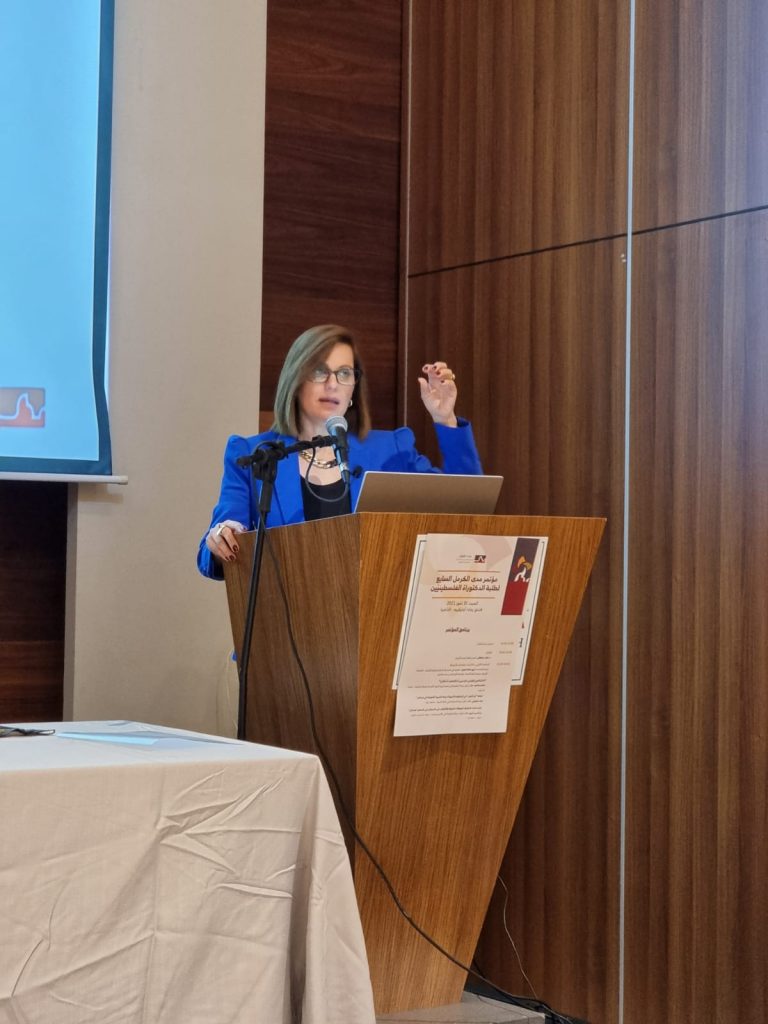
To watch the first session, click here.
To watch the second session, click here.





